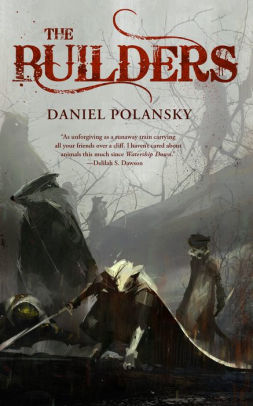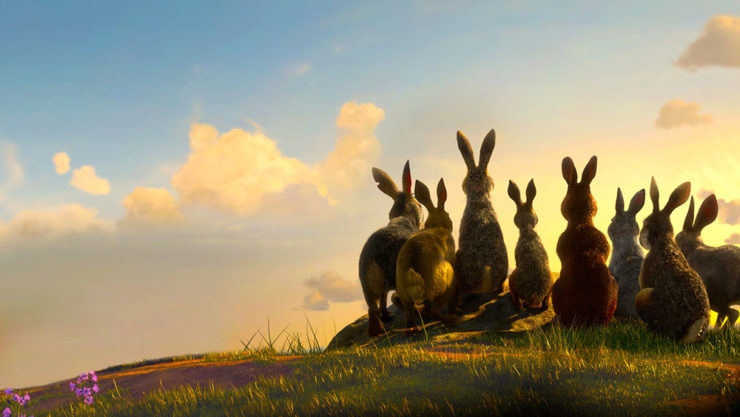With Netflix having recently premiered its new adaptation of Watership Down, now seems like a great time to look back and ask: while zombies, airships, and plenty of other fantasy staples go in and out of fashion, just what is it that gives stories featuring anthropomorphic animals their staying power?
The topic’s been on my mind since a few weeks ago, when I was visiting some friends in the small town of Walla Walla, Washington. Since these friends are lovers of board games, we made sure to play everything they’d gotten for Christmas. The one they were most excited about was Everdell: a gorgeously illustrated game about a lush forest—complete with a 12-inch cardboard tree—populated by badgers, toads, bats, mice, and other animals going about their lives without a human in sight. It was fun to play, but for me, the illustrations were the real draw.
Another recent tabletop favorite of mine is Root, which similarly follows the concerns of forest folk. This time, the mammals, birds, and reptiles of the woods are at war, and the illustrations are stylized and cartoonish compared to Everdell’s relative realism. But the one thing the two games share with each other, and with a diverse array of books, TV shows, and movies, is the lure of the human-adjacent but not quite human—the anthropomorphic.
The Hawk and the Nightingale
One of the earliest examples of authors turning to animals to tell human stories comes from Works and Days, a poem by the ancient Greek Hesiod that doubles as an early farmer’s almanac. Lamenting that mankind has fallen far from the gods’ first and most successful attempt to build a race of mortals, Hesiod uses a fable to illustrate the brutality of the “age of iron.” A hawk grasps a nightingale to carry it off to eat, and mid-flight, scolds the smaller bird for crying out in pain:
Goodness, why are you screaming? You are in the power of one much superior, and you will go whichever way I take you, singer though you are. I will make you my dinner if I like, or let you go. He is a fool who seeks to compete against the stronger: he both loses the struggle and suffers injury on top of insult. (Lines 207-212, M.L. West translation)
This isn’t only interesting as a very early example of anthropomorphism that’s literary as opposed to religious. What’s really fascinating is the number of ways the story of the hawk and the nightingale has been recast over the years. Aesop, the great-grandfather of animal tales, told a story called “The Hawk, the Nightingale, and the Fowler” wherein the hawk is so distracted by his power over the nightingale that he himself becomes the prey of a human hunter. Aesop scholar Ben Perry suggests that the moral of this version is that people who lay traps ought to be careful of traps laid by others.
Still a third version, also (perhaps falsely) attributed to Aesop, appeared a few centuries into the Medieval period, and redefined the scene so the hawk became the hero: instead of a brutal ravager, he’s a model ascetic content with a small but reliable snack, embodying the phrase “a bird in the hand is worth two in the bush.”
The same two animals (sometimes with a human guest star), in the same situation, used to espouse three conflicting viewpoints. It’s a pretty clear clue to the power of anthropomorphic fantasy: fantasy mirrors, warps, and intensifies the real world, and animals are the perfect reflections of humans, in all our ambiguous glory. But there’s more to the story.
The Paragons of Animals
Root and Everdell are far from the only proof that the Hawk and the Nightingale have descendants in the modern day. Animal stories have evolved over the centuries in parallel with the larger body of epic fantasy. Faunal heroes have grown from allegorical ciphers into the Bigwigs, Mr. Toads, and Ms. Frisbys we’re familiar with today, with their own rich worlds around them.
And of course there are as many approaches to building an anthropomorphic world as there are to epic fantasy. Some classics like Animal Farm and The Wind in the Willows portray a world of animal heroes with humans easily accessible, at least to some characters. Others, like Watership Down and The Secret of NIMH, place humans on the very edge of the conflict as terrifying eldritch threats.
And then there’s Redwall. If Watership Down is the Lord of the Rings of anthropomorphic animals, Redwall’s world is more like a Greyhawk or a Krynn: definitely a successor world, but at least as important to the development of the genre as it exists today. With the exception of some stray human-sized carts in the early books, Brian Jacques kicks humans out of the picture entirely to allow the animals develop on their own.
The result is a society whose characters are balanced on the knife-edge between civilization and the wild. David Peterson’s Mouse Guard follows Jacques’ lead in using animals’ real roles in the ecosystem as the basis for worldbuilding—the titular force are responsible for maintaining the few safe paths through the hostile wild between mouse settlements.
Buy the Book


The Builders
Other than the civilized animals, the only thing that’s common to all these works is how hard it is to pin them down. Winnie-the-Pooh and The Jungle Book are for kids (albeit kids of all ages). Animal Farm pretends to be but isn’t, playing with the traditional form of the fable to sharpen its satirical and allegorical edges—its original subtitle, “A Fairy Story,” drives this home. Tad Williams’ Tailchaser’s Song and Daniel Polansky’s The Builders aren’t attempting to be anything but adult-oriented fantasy narratives. In Mouse Guard and Watership Down, the animal characters face realistic threats from worlds where most things are larger and scarier than they are; in Warriors and Redwall, our heroes are the apex predators.
Is there anything we can say that is true about anthropomorphic fantasy as a whole? Anything that explains its remarkable power to draw readers—including me—in, time and time again, regardless of form, genre, or style?
The Clearness of Dawn
Let’s quickly address the elephant in the room (and no, it’s not the fact that I’m talking about a few literal rooms containing actual elephants). Animals are cute. Mice are cute, cats are cute, rabbits are adorable, even toads have a lumpy sort of charisma. However, they’re all less cute when soaked in blood or running for their lives, so as much as everyone likes reading about cute things, there’s got to be something more at work when it comes to the appeal of animal protagonists.
To understand this, I always think back to the famously strange interlude chapter of The Wind in the Willows, titled “The Piper at the Gates of Dawn.” Unworldly Mole and river-loving Rat are searching for a friend’s missing child when they briefly catch sight of the god Pan himself. In the “utter clearness of the imminent dawn,” Mole and Rat are overwhelmed with the nearness of nature’s power:
…(Mole) looked in the very eyes of the Friend and Helper; saw the backward sweep of the curved horns, gleaming in the growing daylight; saw the stern, hooked nose between the kindly eyes that were looking down on them humourously, while the bearded mouth broke into a half-smile at the corners…saw the splendid curves of the shaggy limbs disposed in majestic ease on the sward…All this he saw, for one moment breathless and intense, vivid on the morning sky; and still, as he looked, he lived; and still, as he lived, he wondered.
Afterwards, they remember the incident only as a vague sensation of incredible terror and beauty. Ratty attempts to recapture the feeling through poetry, but can’t quite pin down “the real, the unmistakable thing, simple—passionate—perfect…”
To me, the defining characteristic of animal fantasy stories is the way they have of getting near to that imminent, unmistakable thing. As humans, we’re often too buried in our own structures and traditions to experience the world with anything like the kind of immediacy that Pan represents. Yet it’s natural for a rat and a mole to stumble on such magic, to be more connected to the wild, primal edges of existence.
To cite another example, there’s the excellent webcomic Beyond the Western Deep, whose authors I was lucky enough to meet at Boston Comic Con two years ago. At their stall on the dealers’ floor, Alex Kain and Rachel Bennett told me that in creating the world, they’d been attempting to elevate what could be done with animal stories. They cited A Song of Ice and Fire as an inspiration for their seven races of mammals.
I think their work more than achieves that goal, though I encourage everyone to take a look for themselves. Like Redwall and Mouse Guard, Beyond the Western Deep‘s use of animal characters pulls off the holy grail of worldbuilding: creating a place that’s wholly unlike our own world, yet full of characters that draw us in right away. After all, no author will ever have to pause the story to explain what a squirrel or a dog is.
We don’t just know squirrels and dogs and cats—we long to know them better, to see through their eyes the world where Pan still walks. Our pets and familiar wild creatures have a direct line to that real, unmistakable thing that Kenneth Grahame sought through his Water Rat over a hundred years ago. Experiencing stories through the eyes of animals lets us piggyback on their access to primal feelings and experiences that cut to the quick: real danger, raw emotion, intense wonder, and clear vision.
To me, that stab of immediacy is something all fantasy strives for. Animal stories just employ a bit of a psychological shortcut to get there. It’s why the straightforward meeting of a hawk and a nightingale can be used to condemn the world in one era and teach frugality in another: we’re all just drifting around in boats, coming up with our own lyrics to understand that wonderful feeling, that essential truth we can’t quite remember.
Back to Our Roots
I confess, I love animal stories (enough that I’ve even written one myself). I sit enthralled as each new entry in the genre proves there’s still plenty of life to be found in the old basic ingredients, whether we’re reading about fearsome hawks, adventurous mice, or scheming cats. And what’s really got me excited lately, especially since finishing Watership Down on Netflix, is the persistent thought that there’s an opening right now for a new, generation-defining anthropomorphic epic.
It’s been almost a decade since the final Redwall novel, and while we do still have Warriors and Mouse Guard installments to look forward to, I’ve got a feeling there’s something big coming around the bend—a tale massive in scope and diverse in zoology, a Memory, Sorrow, and Thorn of mice, squirrels, and toads. It could be Beyond the Western Deep, or something totally new and unexpected—either way, I’ll be playing Everdell until the time comes for my next literary trip to the Gates of Dawn.
Samuel Chapman is a writer who lives in Portland, OR with his girlfriend, a lot of smoked fish, and a perpetual drizzle. His short fiction has appeared in Metaphorosis, Buckshot, and Third Flatiron’s Terra! Tara! Terror! anthology, and more of his thoughts can be found on his blog, “To Find the Colors Again.” He also accepts freelance jobs on his professional website, and tweets Christmas crossover crises and unsolicited Sly Cooper quotes at @SamuelChapman93.










